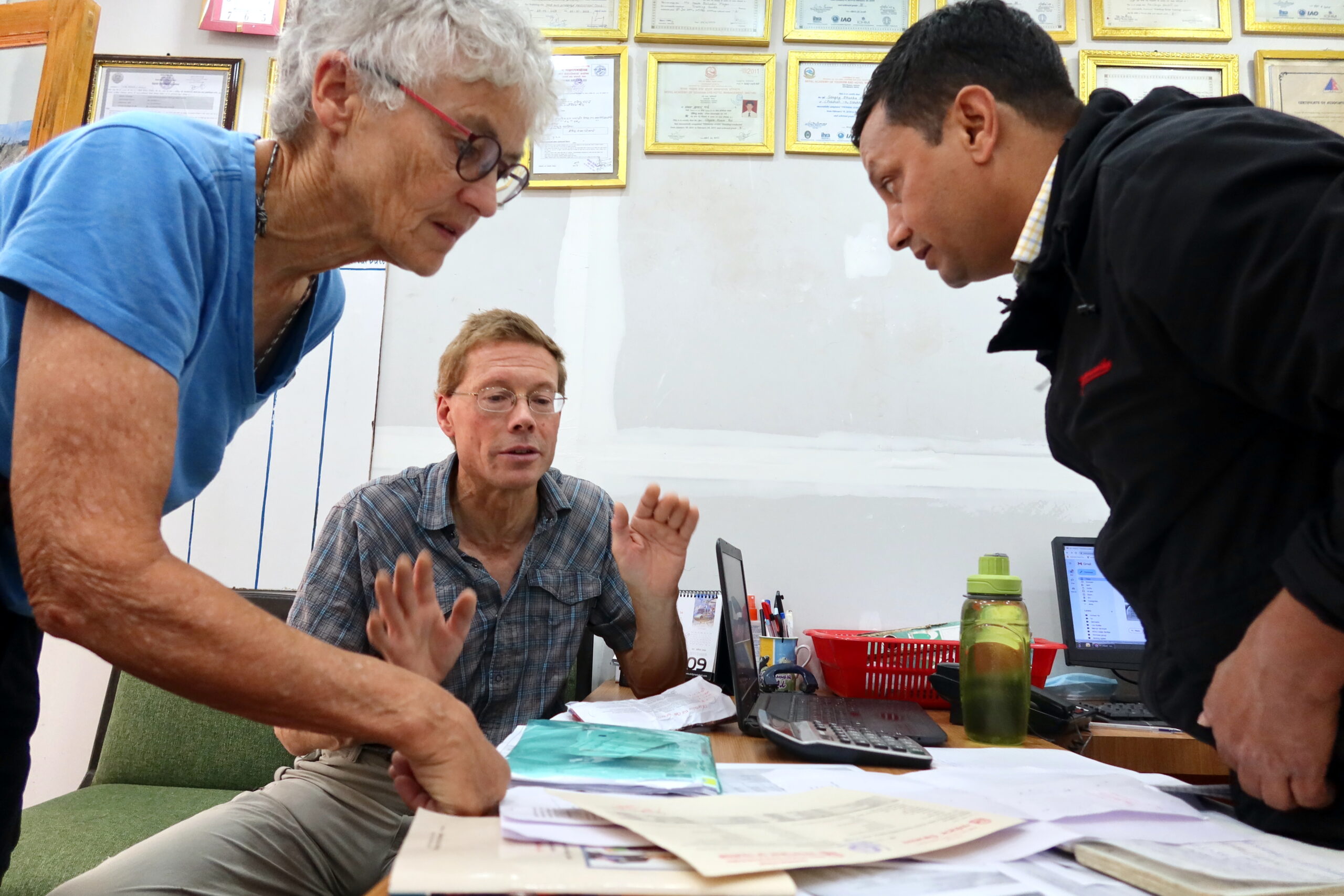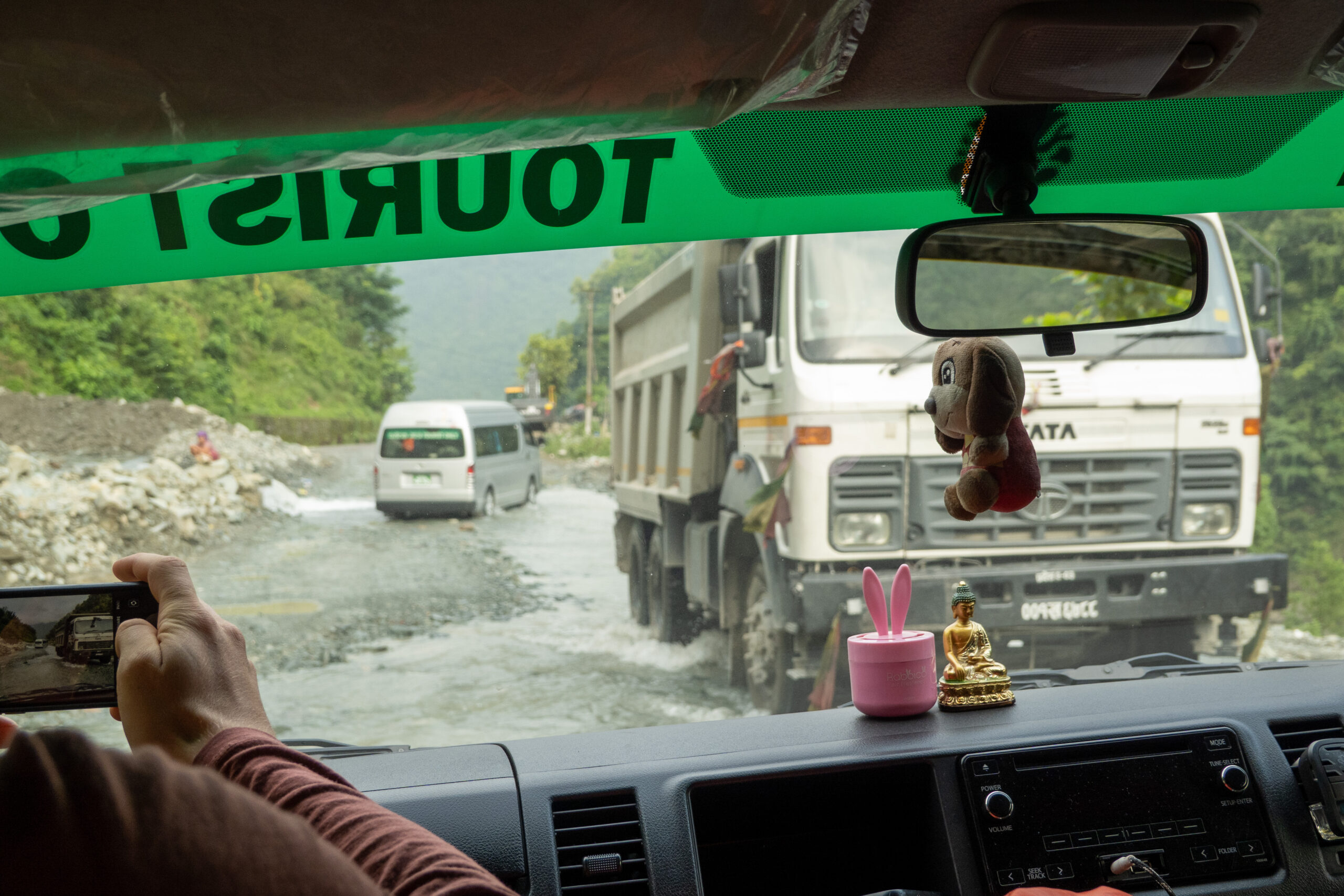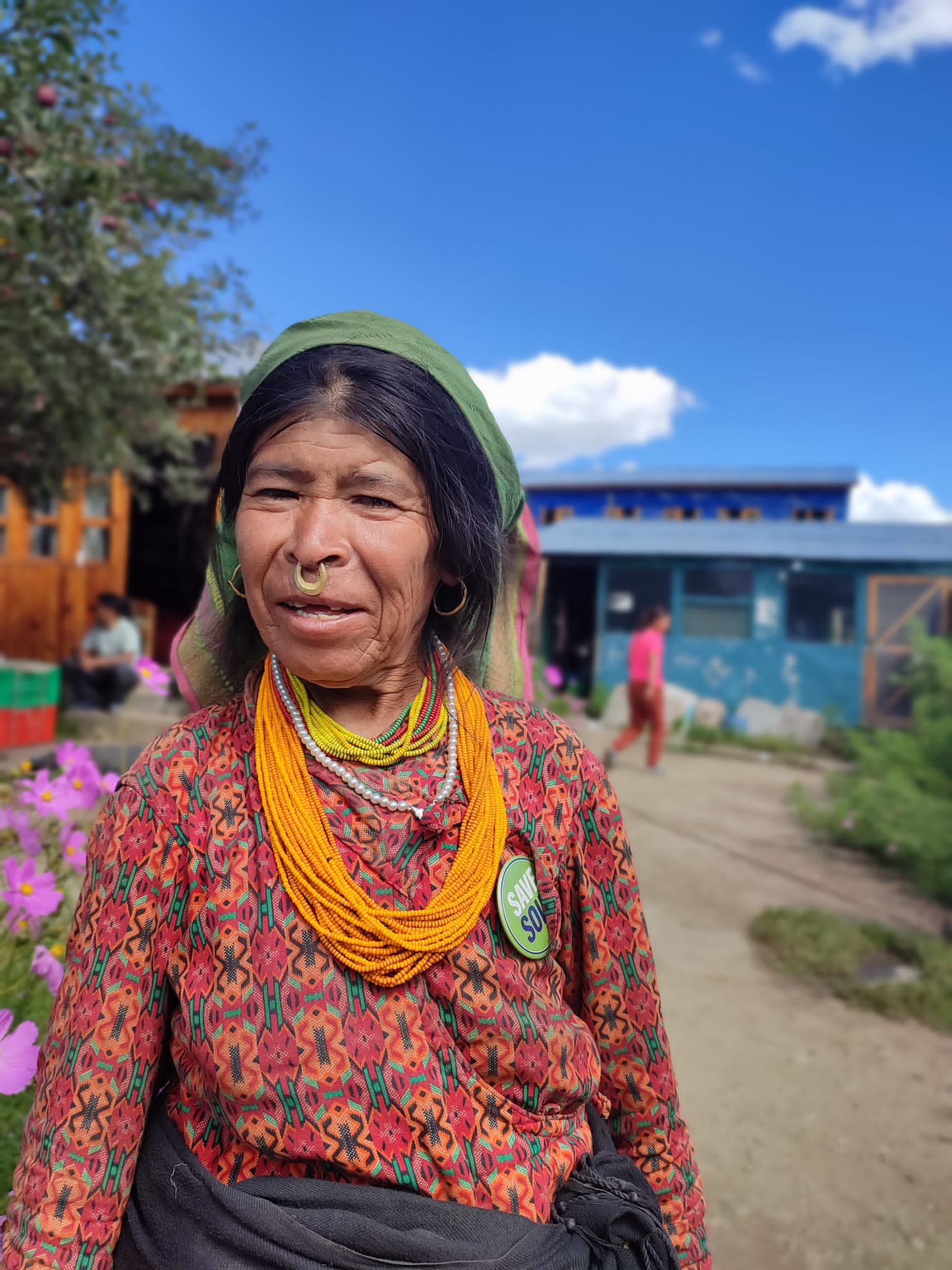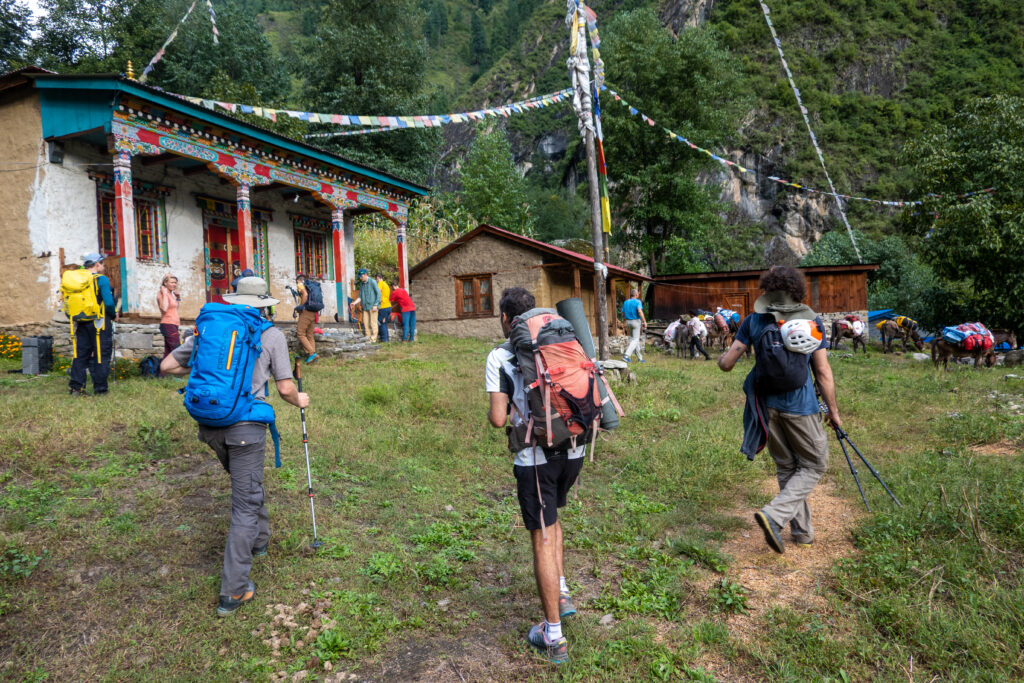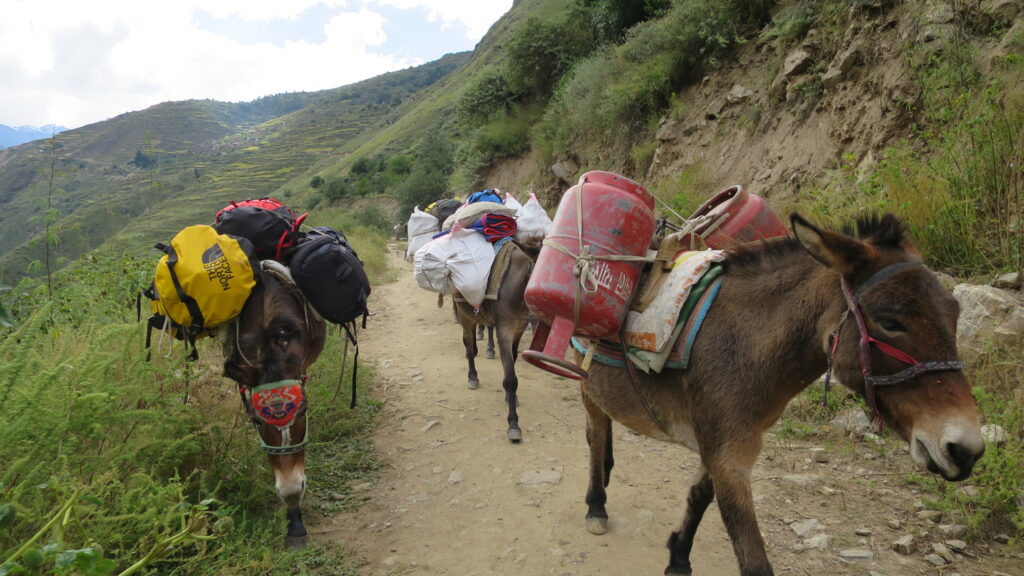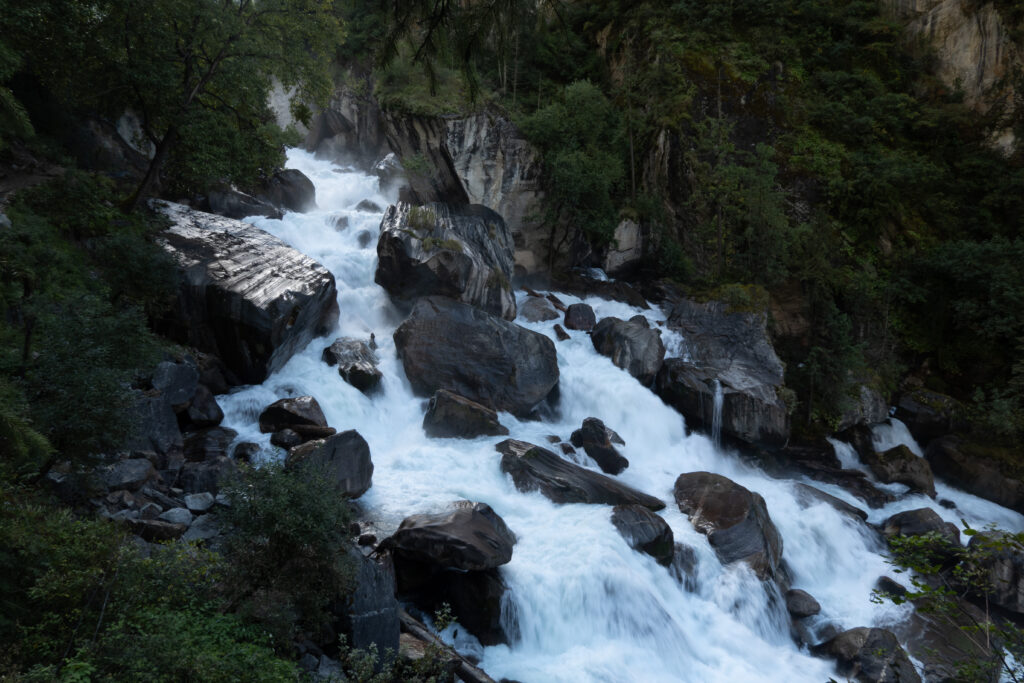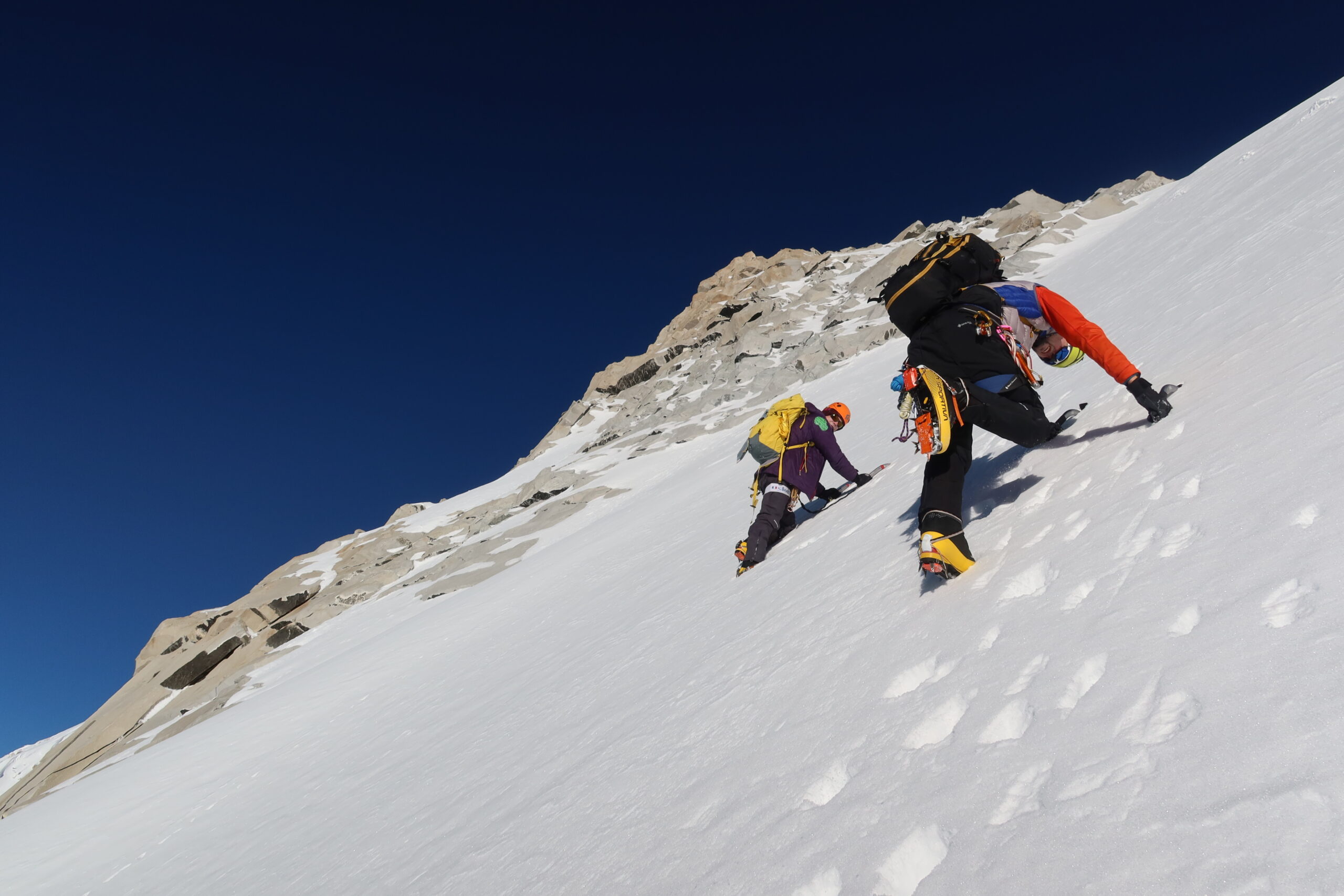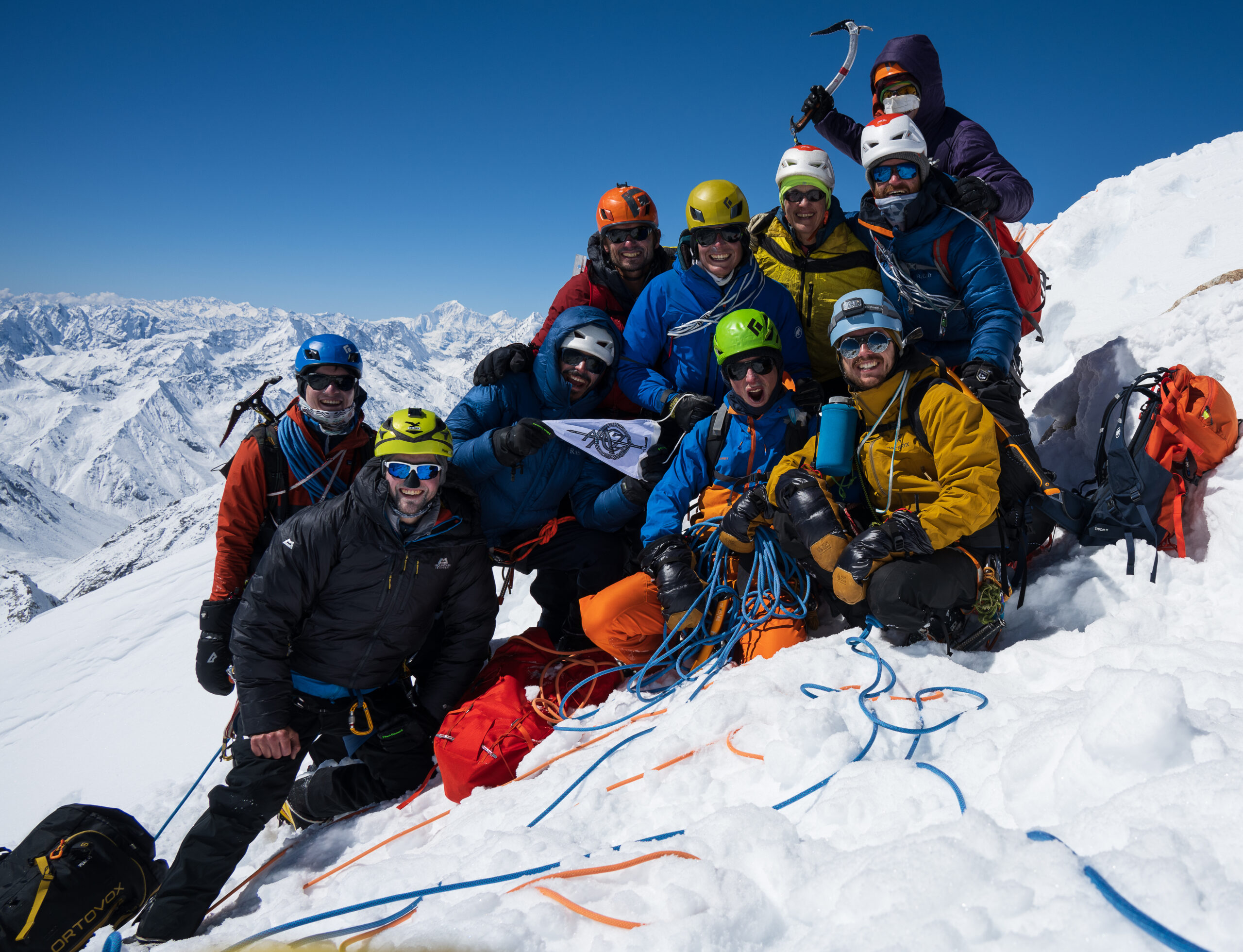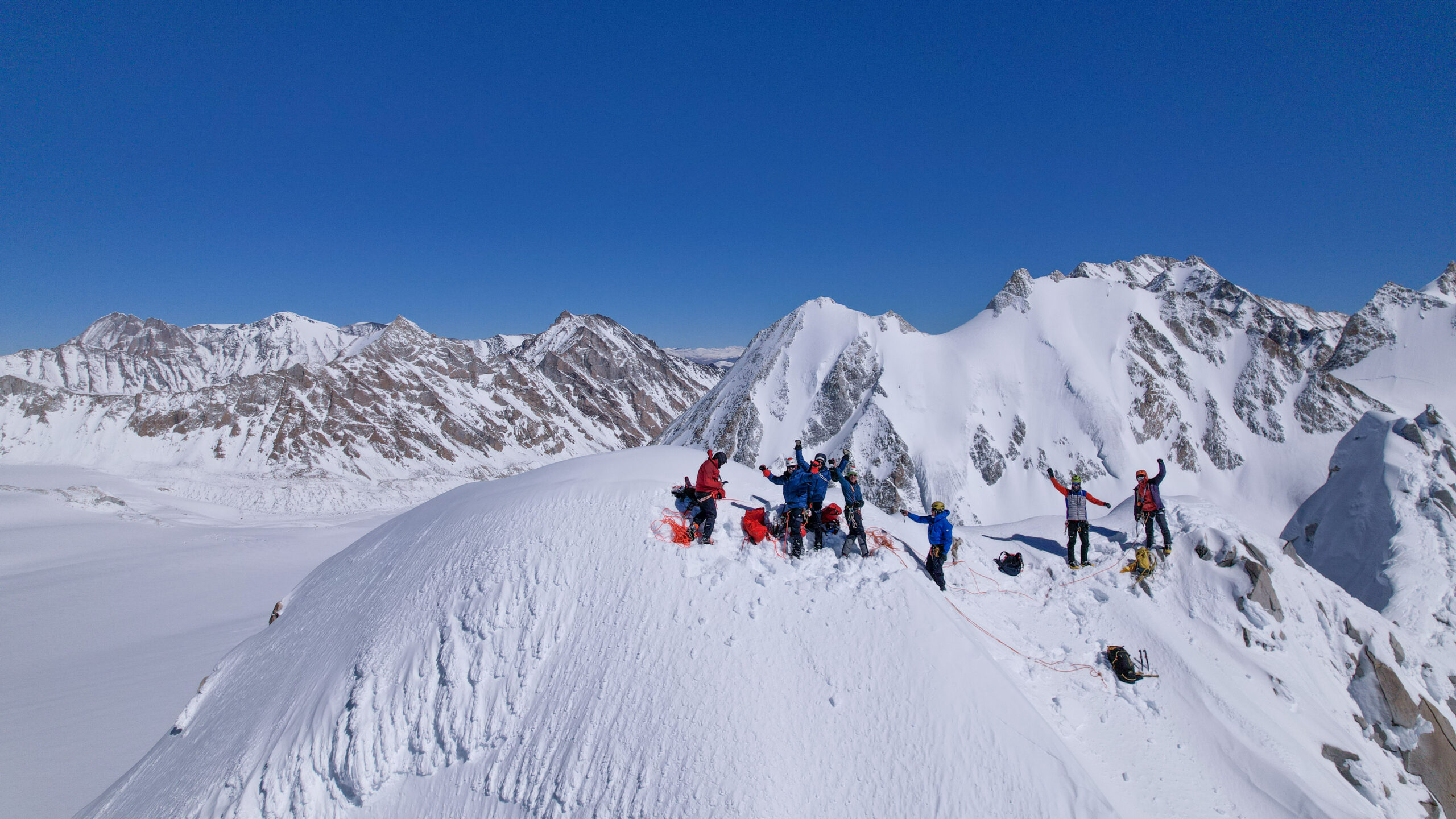- Announcement and preparation of the expedition
- Expedition daily update blog
- Aid projects, supported by the expedition team
- Labelled Expedition Pictures on Himalaya-info.org
Expeditions to the planet’s higher and wilder mountain ranges are an experience for all, not just for some elite climbers. This ethos provided the challenge of finding a remote area suitable for a club expedition, meaning with a wide range of climbing difficulties to appeal to a broad cross-section of the AACZ membership. After considering a range of targets (including Antarctica, Greenland, Myanmar and the Indian Karakoram), practical and political reasons directed us to West Nepal where, far from the 8000m circus, there are many ranges of 6000m peaks that have seen little exploration.

The Changla Himal (map) is one such range. A Japanese team climbed the highest peak, Lachama Chuli from Tibet (where it is known as Kubi Kangri, 6721m) in 2008; in 2015 Mick Fowler and Paul Ramsden climbed the north face of neighbouring Gave Ding (6521m), for which they won a Piolet d’Or. Our headline photo, and others from a 2018 reconnaissance by Bruce, indicated that the mountains of the Changla Himal offer huge potential for exploratory and alpine-style mountaineering at all skill levels.
Team
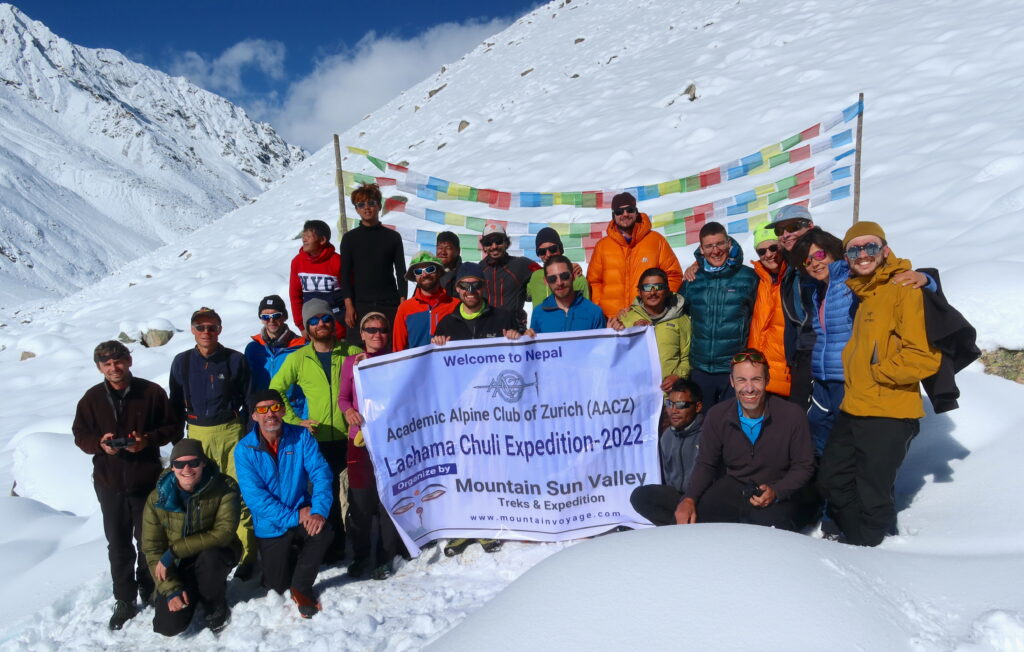
Alex, Andi, Bruce, Charlotte, Christian, Daniel, Felix, Gedas, Hansueli, Javi, Manu, Max, Sarah, Steve, Ulla, Ven, Yannick, Yannick, Yoann and Nepali staff members Amrit, Lhotsu, Naranath, Shekhar and Sujit.
Preparations
Different subgroups of the team members were formed to tackle the many tasks involved in organising a successful expedition: the agent, budget, maps and climbing routes, flights, insurance, medicine, communications, equipment, electronics, climbing team organisation, sustainability and aid projects, internet and social media.
As team activities we organised medical training, technical training and their combination – mountain rescue training. And of course we also climbed mountains (in the overheated Alps).
Expedition
Kathmandu, 25-26th Sept. The red-eyed team gathered in Kathmandu on the morning of 25th Sept. The next 2 days were all work, first finalising the climbing and trekking permits with the untiring assistance and infinite patience of our agent, Rajendra Dalal of Mountain Sun Valley Treks and Expeditions, and then dealing with the irritating and useless liaison officer. One team dealt with emergency high-camp food purchases, others spearheaded the synchronisation of all our satellite communication devices and others still kept track of the money. Sarah led a delegation to visit the new Kathmandu clinic of Ek Ek Paila (link to section below), the Nepalese medical NGO for which we raised funds in 2021.
On the road, 27th Sept. At 3am we loaded all our equipment into 2 minivans, finding it a tighter fit than anticipated, and hit the road for Nepalganj. This 17-hour road trip provided our first sight of the real Nepal, or at least the reality lived by many Nepalese: dust, diesel, delays and the heat of the Terai. Our drivers were entirely used to it and did an excellent job, but still the air-conditioned hotel in Nepalganj was a welcome oasis for all.
Simikot, 28th Sept. Another early start had us watching sunrise at the airport, trying to check and weigh 1 ton of baggage. Simikot is the capital of the Humla district, the most impoverished region in Nepal, and has no road access. The mandatory flights (our group needed 2) in a 20-seater aircraft whisked us over 200km of precipitous green foothills in only 40 minutes and provided distant glimpses of giant white peaks, but also underlined the contrast between the extreme beauty and extreme poverty of upland West Nepal. In Simikot we met our cooking crew, who were too busy packing to talk much. While a few members of the team worked on an emerging crisis with our EPI gas supply and others tackled the bad attitude of our Simikot outfitter and his guide, the majority set out to follow up our contacts with different aid projects (link to section below): RIDS Humla, Simikot hospital (Ek Ek Paila), Mahila Avaz (women’s shelter) and Project UKALI (snow leopard conservation and biodiversity research). Unfortunately this was the day that our Covid outbreak started, with 2 members spending the afternoon in bed, 2 others feeling decidedly poor and everybody trying to implement some kind of isolation measures.
Trek in, 29th Sept to 2nd Oct. With 2 tons of food, fuel and equipment, we were not going to sell ourselves as a “lightweight expedition.” This cargo required 44 mules, which we did not get to see as a single train until the third day, although this sight showed like no other the scale of our undertaking. On the first morning, our baggage disappeared to different parts of the village and the different groups of mules gathered at the end of the day. This day involved a long, eastwards descent from Simikot to the river and then a short climb to the last village, Dojam, where we were told to camp in the grounds of the small temple.
The second day took us on a steep climb up the impressive Chuwa Khola, through forested slopes above the wild river. The going was slow due to a massive flux of nomadic people coming down with all their animals (sheep, goats, yaks, horses) at the end of the grazing season, while some other locals were gathering a cargo of roots. The available flat camp site, at a river junction at 3400m, made this a tough day both for the mules and for the increasing number of members who were going down with Covid.

On the third day, the steep cliffs and forests opened suddenly to a flat, wide “grassland” along the valley floor, giving a first taste of the Tibetan plateau to the north, and our camp at 4000m provided the first views, up the Lachama Khola, of truly high peaks to the east. At this point our weather forecast was becoming increasingly certain that a protracted storm was going to bring extreme amounts of rain and snow to the entire Himalaya, and this started to alter our strategy.
On our final day to base camp, packing and departure were delayed by 2 hours due to a rain storm, and then the “guide” and mule men were adamant that the last camp was at 4400m, 8km and 600m short of the location we had explained to them. Faced with some tough terrain for the mules and the certainty of being in a place where all the precipitation would come as snow, we chose the low camp.


Base camp, 3-4th Oct. Despite BC not being where we wanted, we had to deal with it (and in hindsight it would turn out to have been a good decision). With the help of our local staff we held a small Puja (blessing ceremony, seeking the gods’ benevolence for our efforts to climb up to their homes) and hoped for the best regarding the “20-200cm” of snow that were on the way, starting on the 5th. This gave us 2 days for express reconnaissance missions to both the N and the S Forks of the Lachama Khola, during which all the members (several to the best of their Covid-limited ability) hiked to points as high as 5500m in the N valley and 5400m in the S valley to snap what photos we could (and for Andi to fly the drone as high and far as he could), in order to inform our upcoming climbing decisions. We were all struck by the variety of climbing targets, from walk-ups to a vertical ice line, and by the presence of multiple large granite walls, which none of the previous visitors had mentioned.
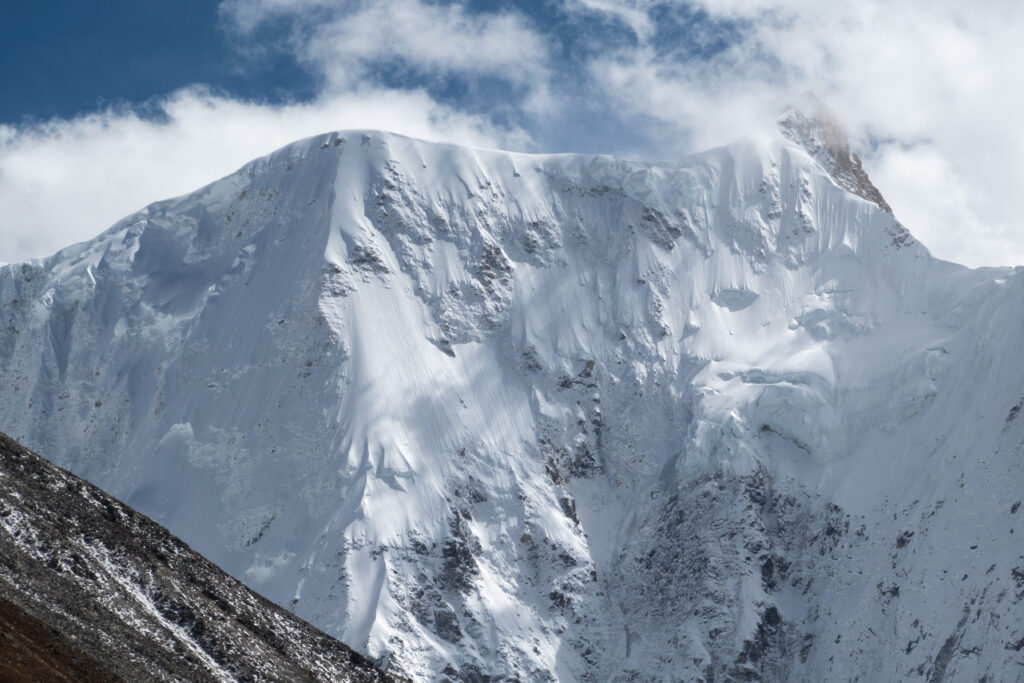




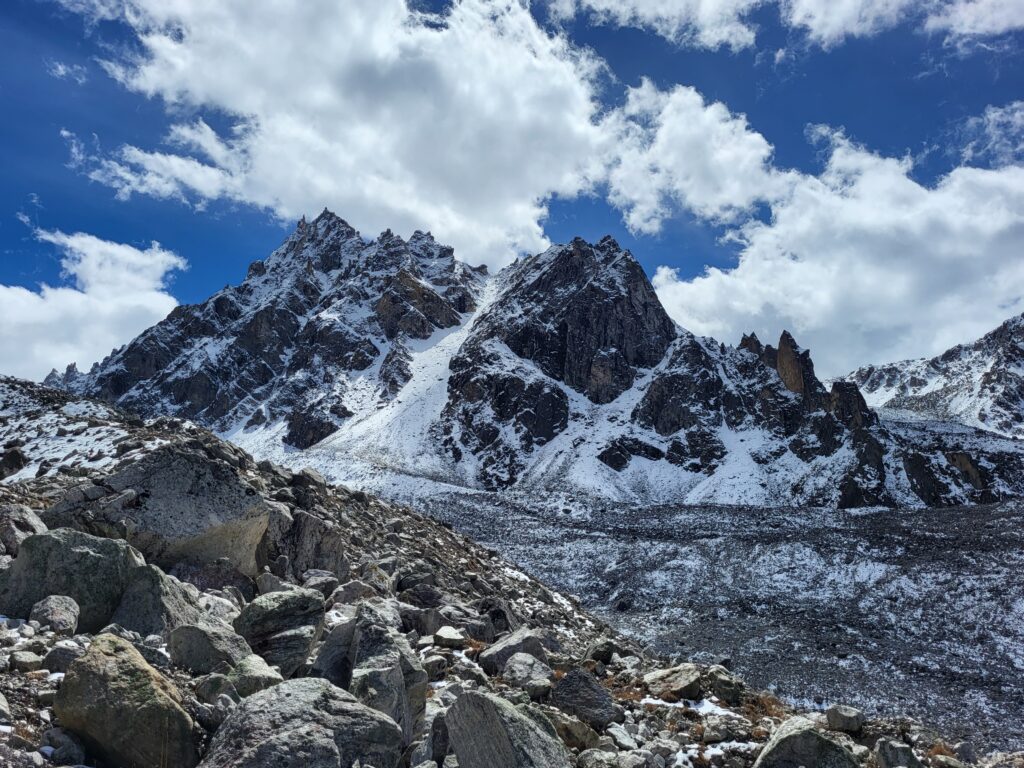
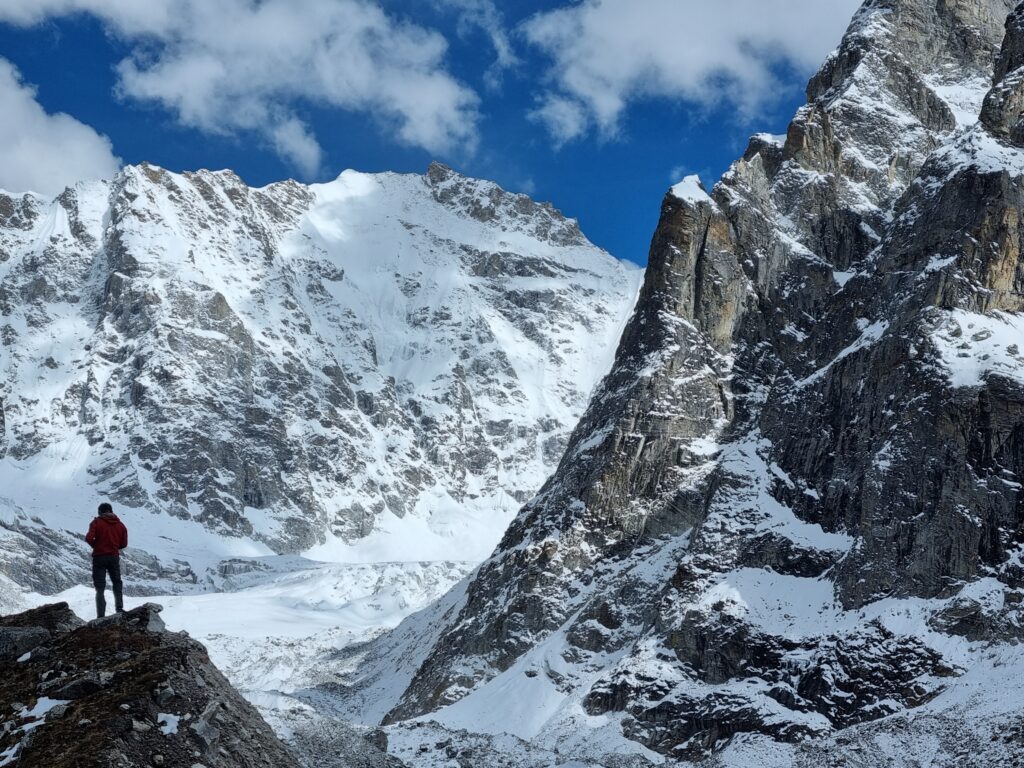
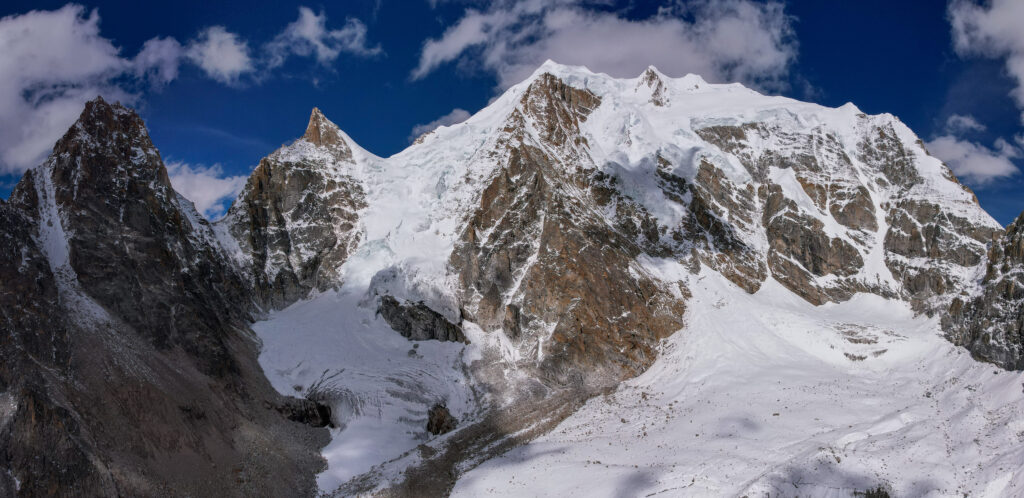
Snow, 5-9th Oct. Snow began on the afternoon of the 5th, and at first compacted down well by being half rain during the days of the 5th and 6th. However, overnight it piled up as heavy snow, threatening the poles and fabric of our big tents and consigning us todays of digging. Some brave members used the daytime to hike up-valley, making a trail and keeping it open. Others were able to use the time to recover from their Covid. By the 9th we had seen 1m of snow and still had 60-70cm piled up around us. We had suffered no serious damage to our equipment, or to anybody’s health, but certainly to our hopes. There would be no small groups of climbers heading to multiple different goals, only protracted trench warfare with every able-bodied member contributing to the breaking of a single trail.
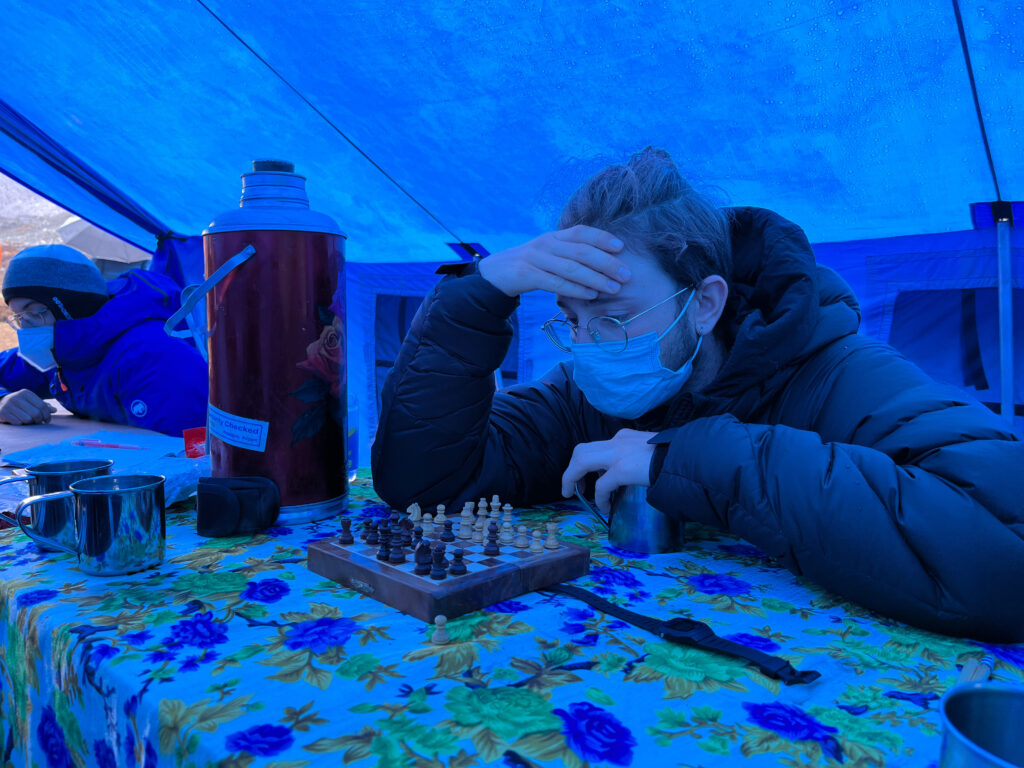
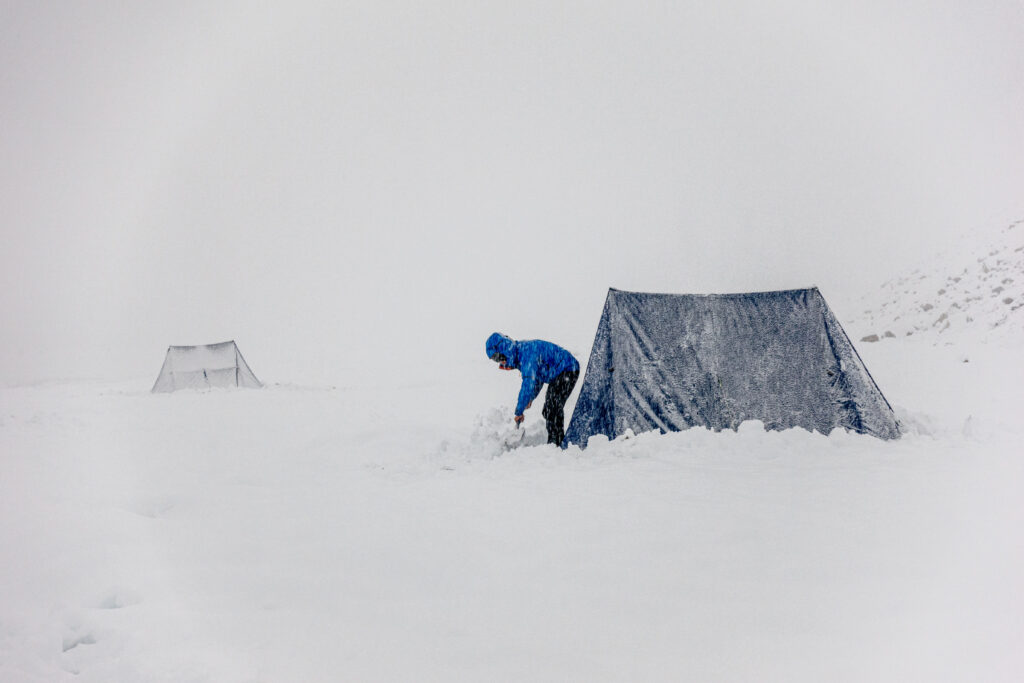
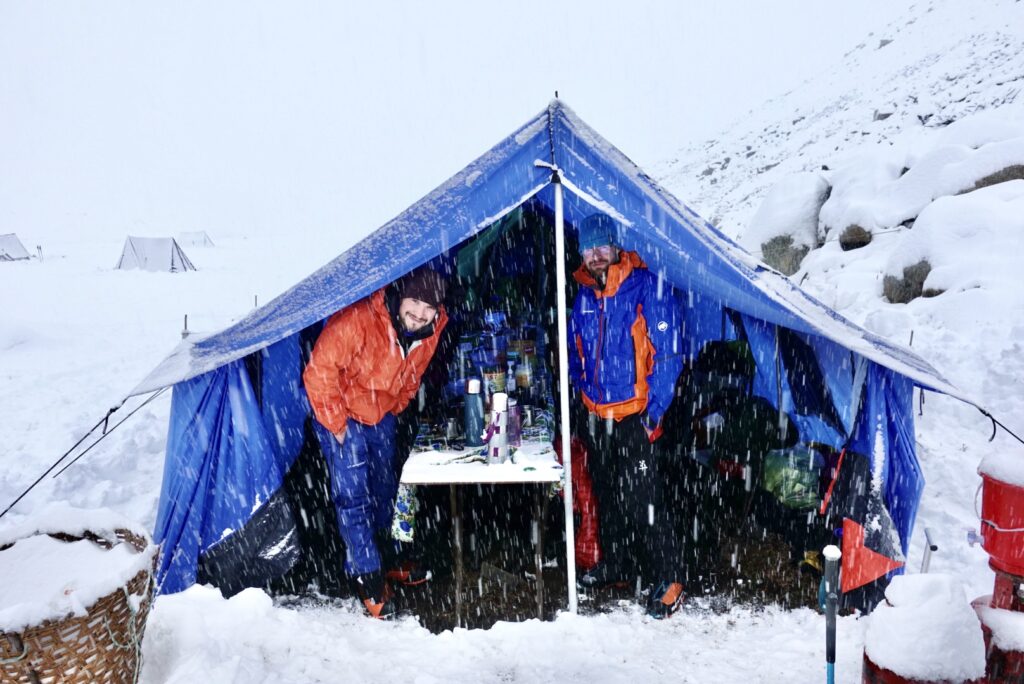
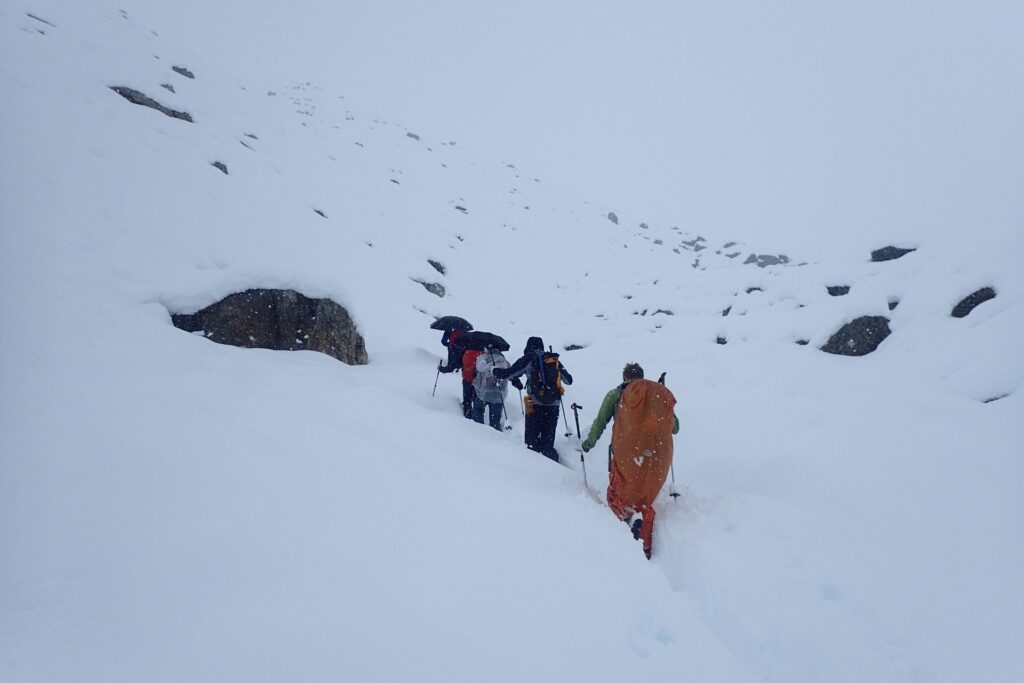
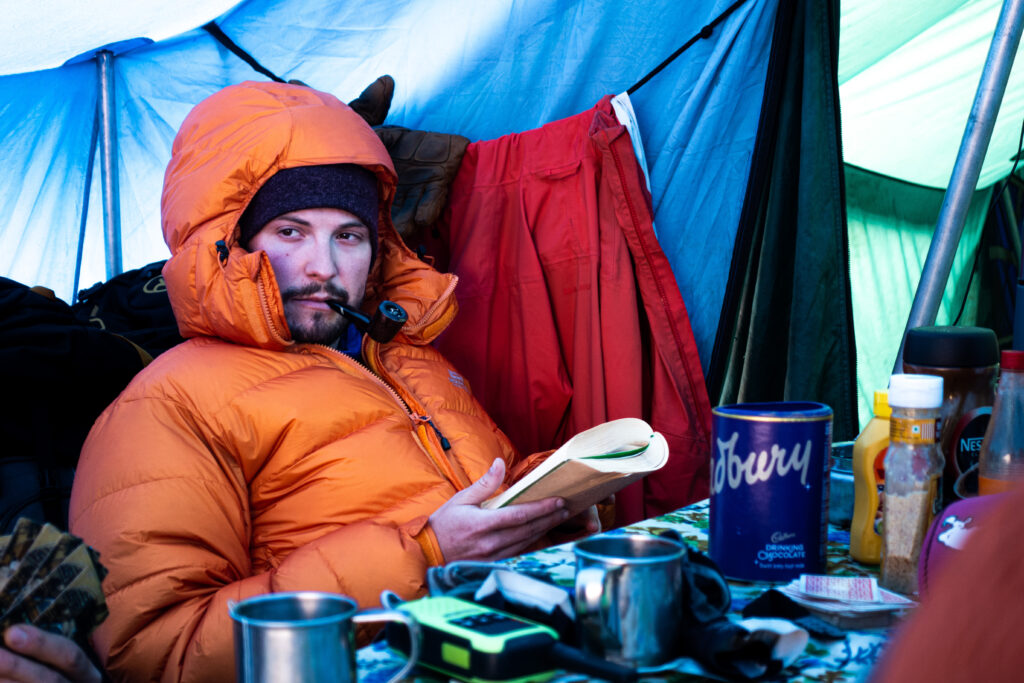
North Valley climbing, 10-17th Oct. 15 members set out eastwards, requiring several days to break trail and shuttle loads along the N side of the Lachama Glacier to the “Polish BC” (4700m) and then to Lachama Lake (5000m). The team decided that the closest suitable peak for this acclimatisation phase was P6122, located 7km north of Lachama Lake, and needed 2 more days of heavy trail-breaking from Camp 1 at the lake to establish Camp 2 at 5600m.
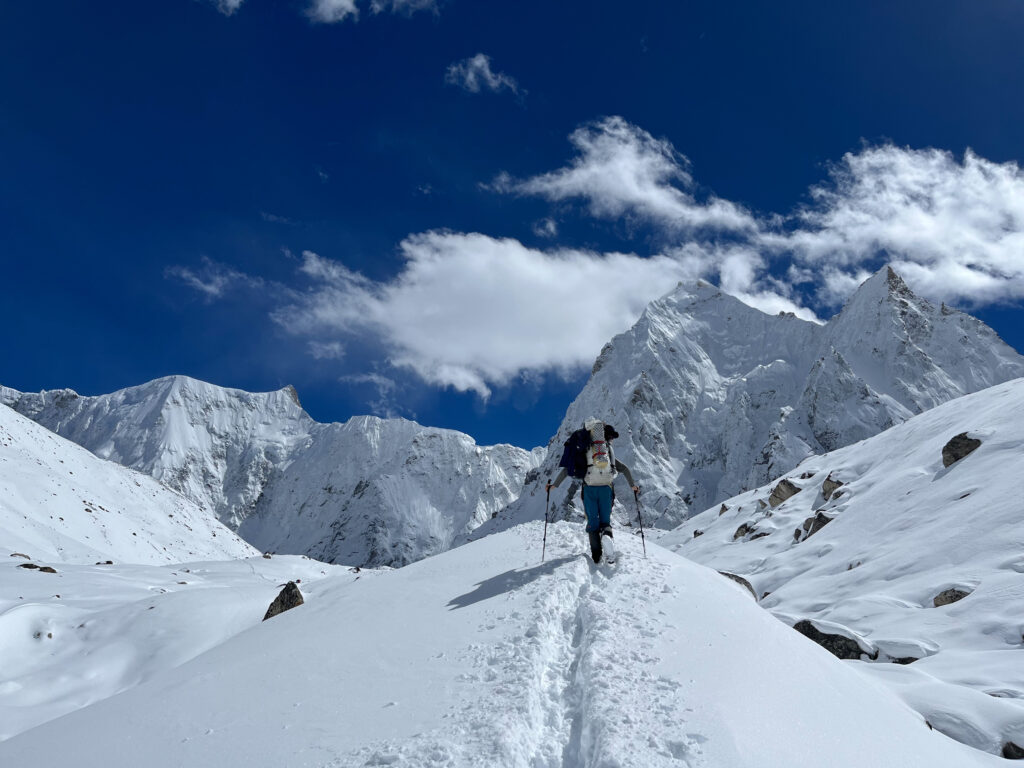
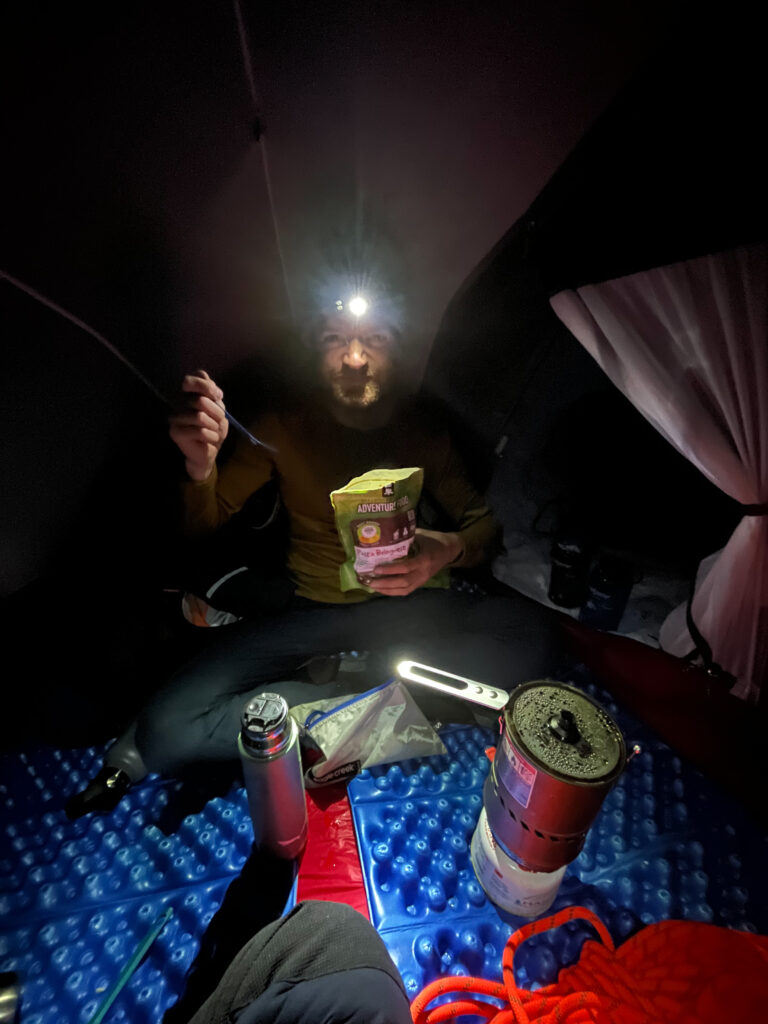
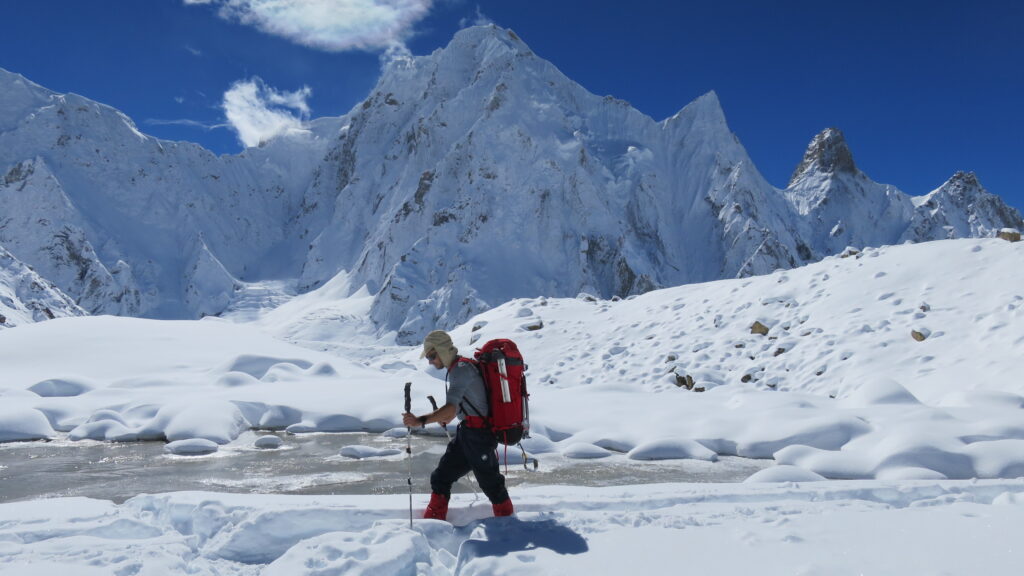
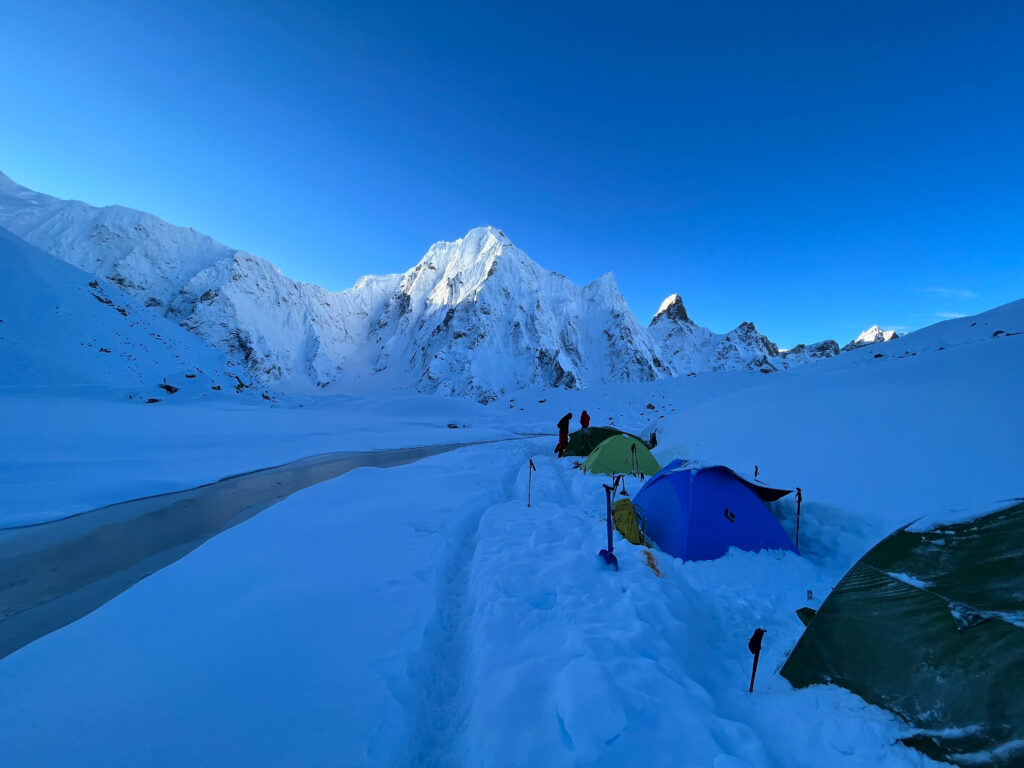
On 16th Oct, led by the rope team of Daniel, Gedas and Hansueli, Andi, Charlotte, Felix, Javi, Max, Yannick and Yannick all made it to the summit of P6122 by the E Ridge, climbing snow to 50 degrees and rock to Grade III. They enjoyed a crystal clear day with low wind and extensive views, particularly south- and westwards across the peaks of W Nepal, and all returned safely to BC over the next 2 days. Of the others, Bruce, Christian and Steve were ill or weak due to illness, Alex had had a small accident below C2 and Sarah was too busy caring for them all to think about climbing …
Second climbing phase, 18-22nd Oct. Over the following days, the climbers split up in the spirit of the original planning. Daniel, Gedas and Hansueli made a brave attempt to reach a spectacular ice line on the N Face of the rock tower P6076, but were beaten by the heavy and unconsolidated snow on the approach. Andi, Charlotte, Javi, Max, Steve and Yannick R made a bid on P6233, directly above Lachama Lake, with Andi and Javi fighting to 6000m before abandoning their effort for the same reason. Felix and Yannick W joined the rest of the invalid team, some of whom made it as far as C2, but again nobody had enough energy for the deep snow and everybody was starting to worry about our homeward mule transport.




South Valley climbing, 10-19th Oct. Manu, Ulla, Ven and Yoann decided at the outset to seek solitude in the south fork of the Lachama Khola, and thus shared 10km of hard trail-breaking work only 4 ways for over a week. They identified a south-facing gully leading to the rocky S Ridge of P6076 as their most interesting (and feasible) option, ultimately reaching the Central Summit (c. 6050m) on 18th Oct. Their route involved 2 pitches of rock up to Grade V and several more lengths of roped scrambling to reach their high point, from which they also enjoyed views over the untouched peaks to their south. They suggest the name “La Sum” for P6076, after its 3 separate summits, which are clearly visible from the west.

First camp in the South Valley 
Steep snowfield to reach the South Ridge of P6076 
Climbing blocky ground on the South Ridge 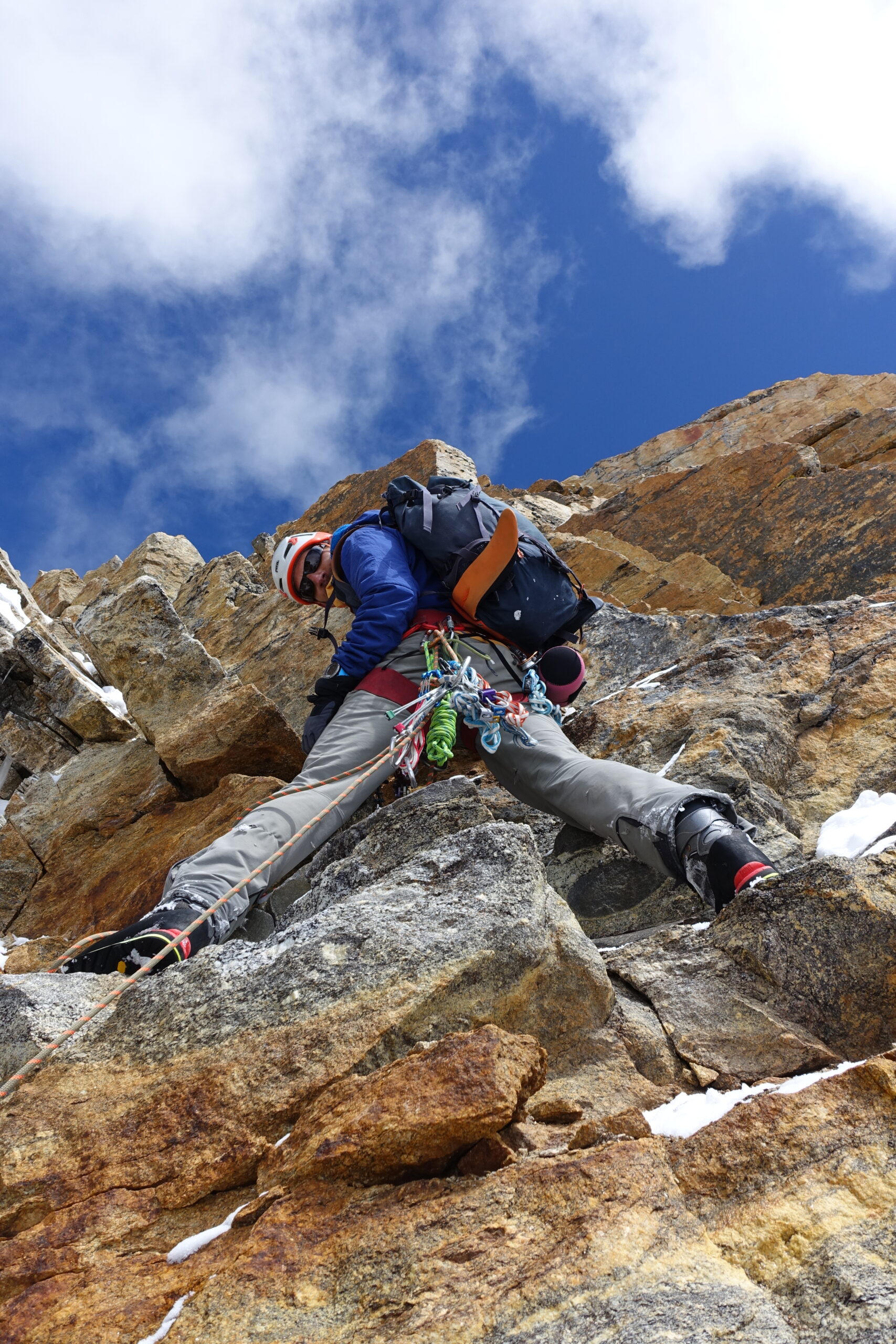
Ven leading the first Grade IV section 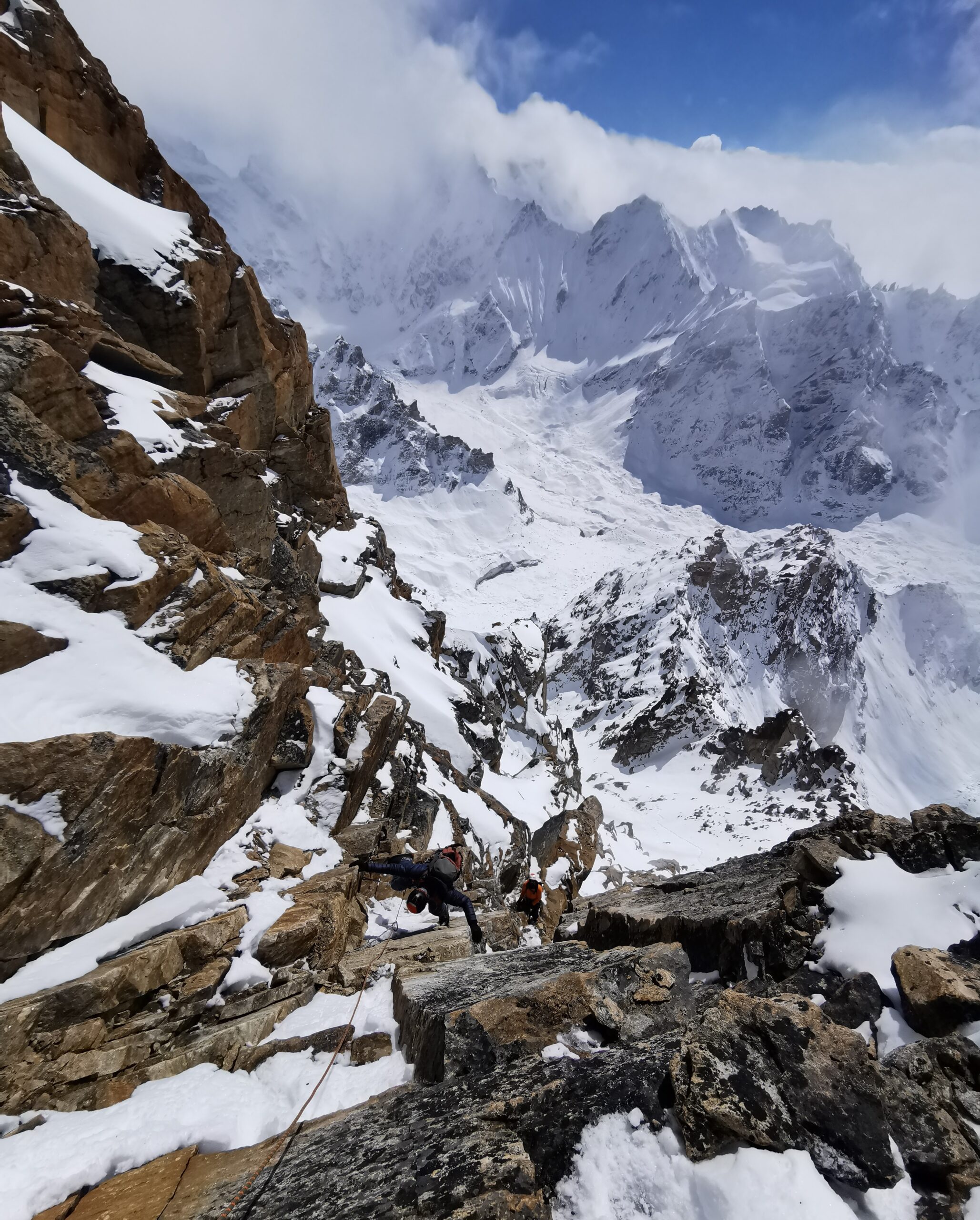
Manu following, with a panorama of the South Valley beneath 
Ulla belays Manu high on the route 
Summit! 
Crossing the delicate traverse on the descent 
Below the abseils at sunset 
Aerial view for the route to the summit
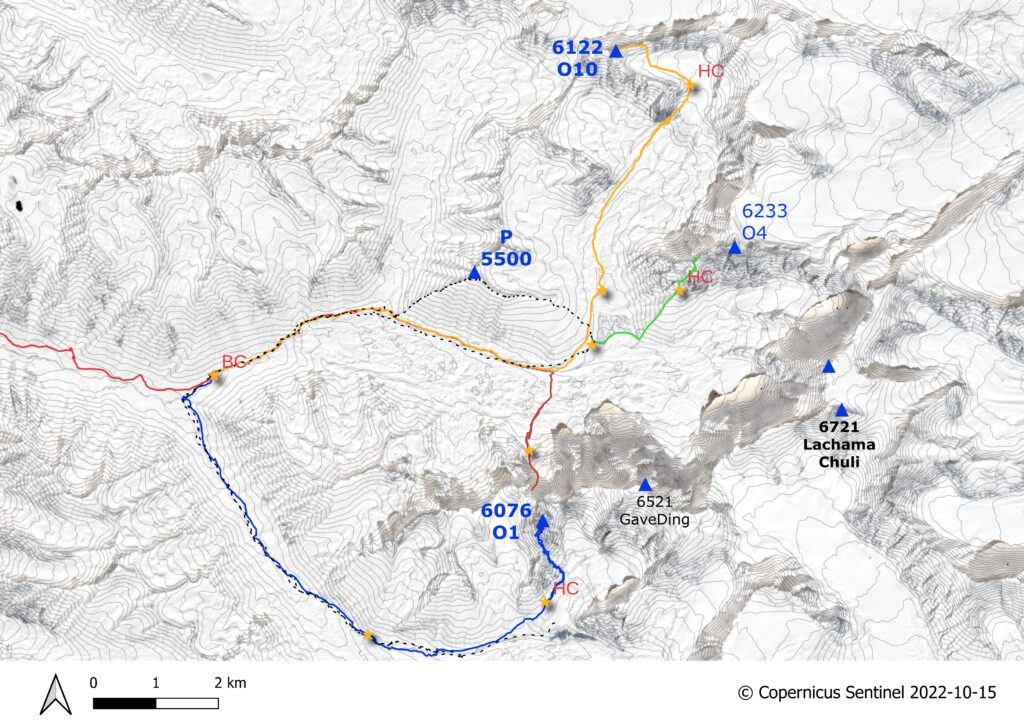
Trek out, 23-25th Oct. In BC we had been joined by the small Polish team of Marcin Rutkowski and Marco Schwindergall, who had planned to finish the former’s partial 2018 route on the northwest face of Lachama North, but were beaten by the storm before even starting. Marcin and Marco made a trail all the way to the bottom of the Lachama Khola, and their mule man was able to make it most (but not all) of the way up to BC. We were preparing for the worst, in the form of multiple heavy carries to get our entire BC down to the mules’ high point, when our snow mules appeared calmly in camp on the evening of the 22nd. Walking out, we found there had been no traffic at all in the Chuwa Khola, and the snow cover persisted as far as the tree line at 3800m. Lower down, the team took understandable delight at the warmer temperatures, swimming options in the river and “rice water” in Dojam village.
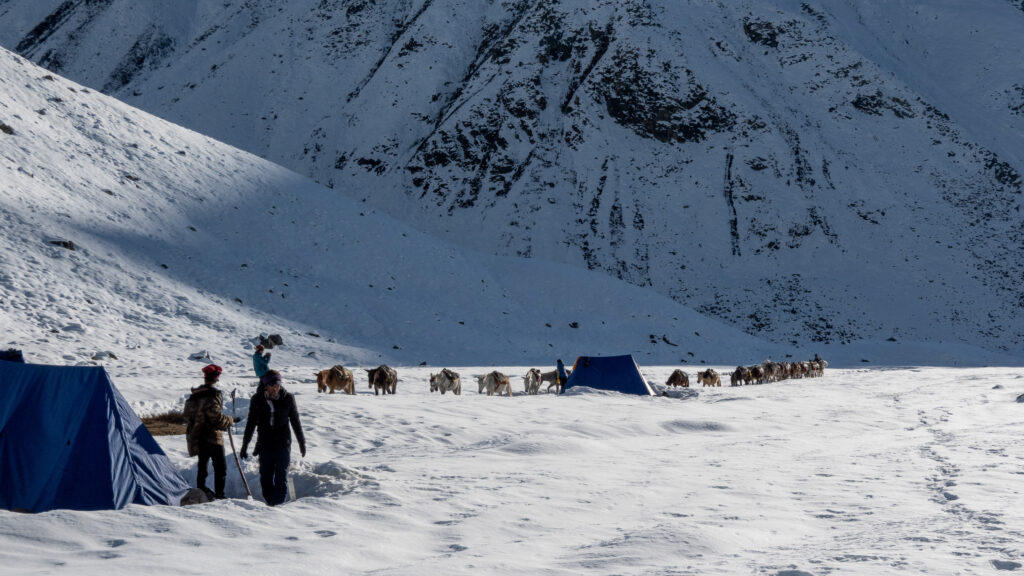
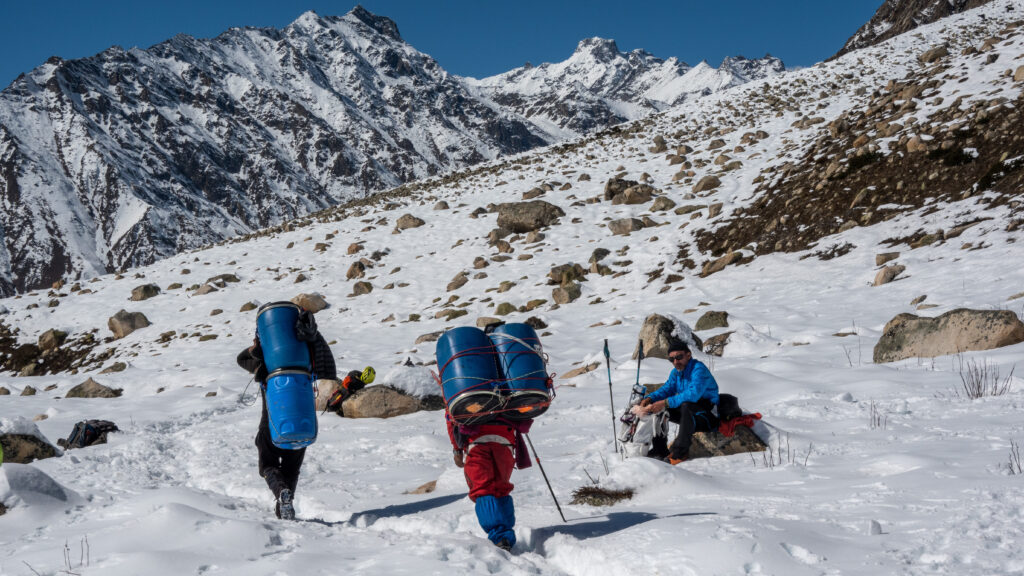


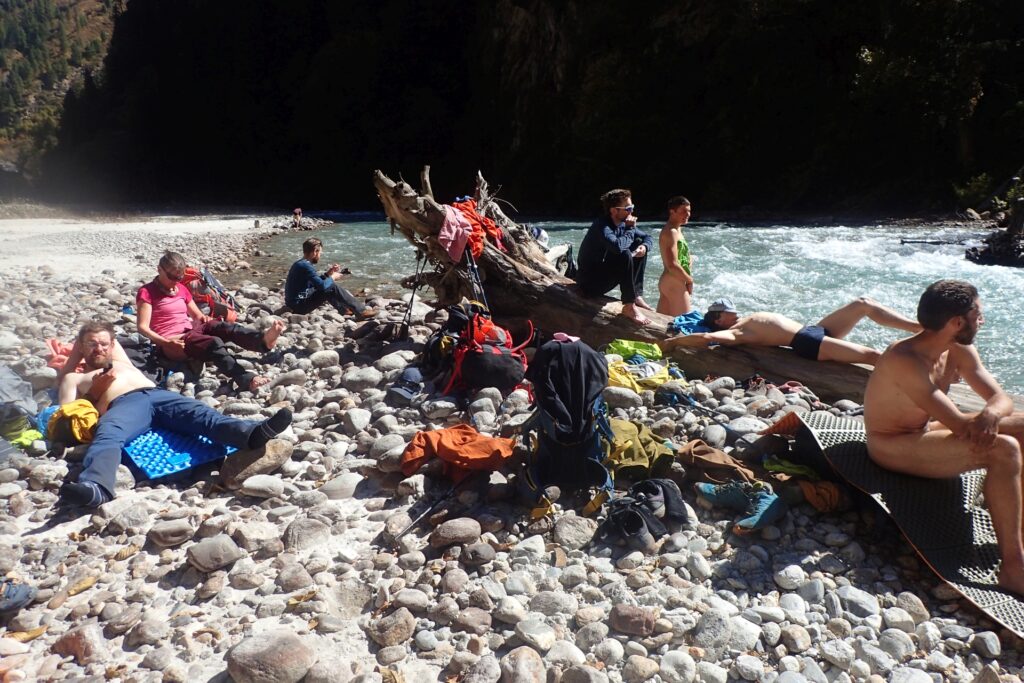

Simikot, 26th Oct. The final day required an uphill hike of 500m back to Simikot. Here we put all our aid concepts into practice by donating the remaining medicine to the hospital, all the gas and mountain food to Project UKALI for snow-leopard fieldwork and all the remaining base-camp food to the women’s shelter. Summit Air spoiled our return plans by offering only one flight on the 27th, leading to a seat lottery that gave the losing members the opportunity to “enjoy” the regional capital of Humla for another 24 hours. We paid generous and fully deserved tips to Sujit and Amrit for their month of work, and some members danced late into the night (9:30pm).

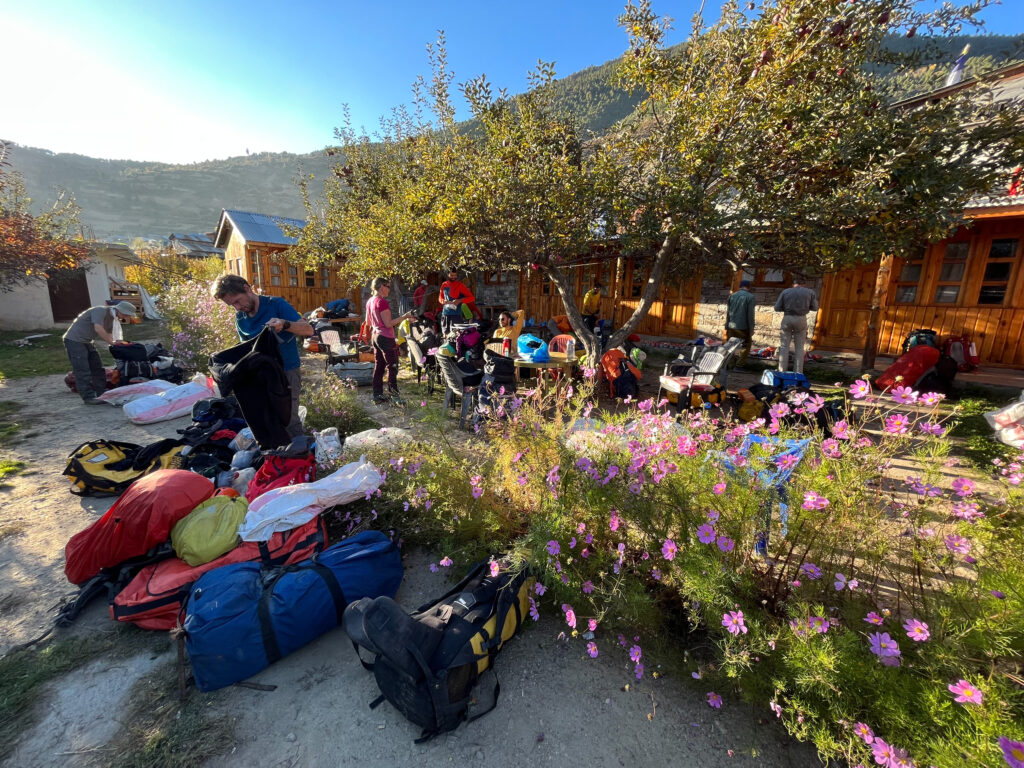
Nepal tourism, 27-29th Oct. Our return to Kathmandu took place in excellent weather, allowing the team to make the most of its Nepal flightseeing opportunities. The evening of the 28th saw our final official act as a complete team, reconvening with Lhotsu, Naranath and Shekhar to give them tips worthy of all their work for such a giant team. Kathmandu saw some intensive tourism. Bruce and Gedas reconvened with Rajendra to deal with final financial issues and retrieving the “garbage deposit.” Charlotte, Daniel and Max set off for another adventure in Nepal or India and the rest of the team left for home on 30-31st Oct.
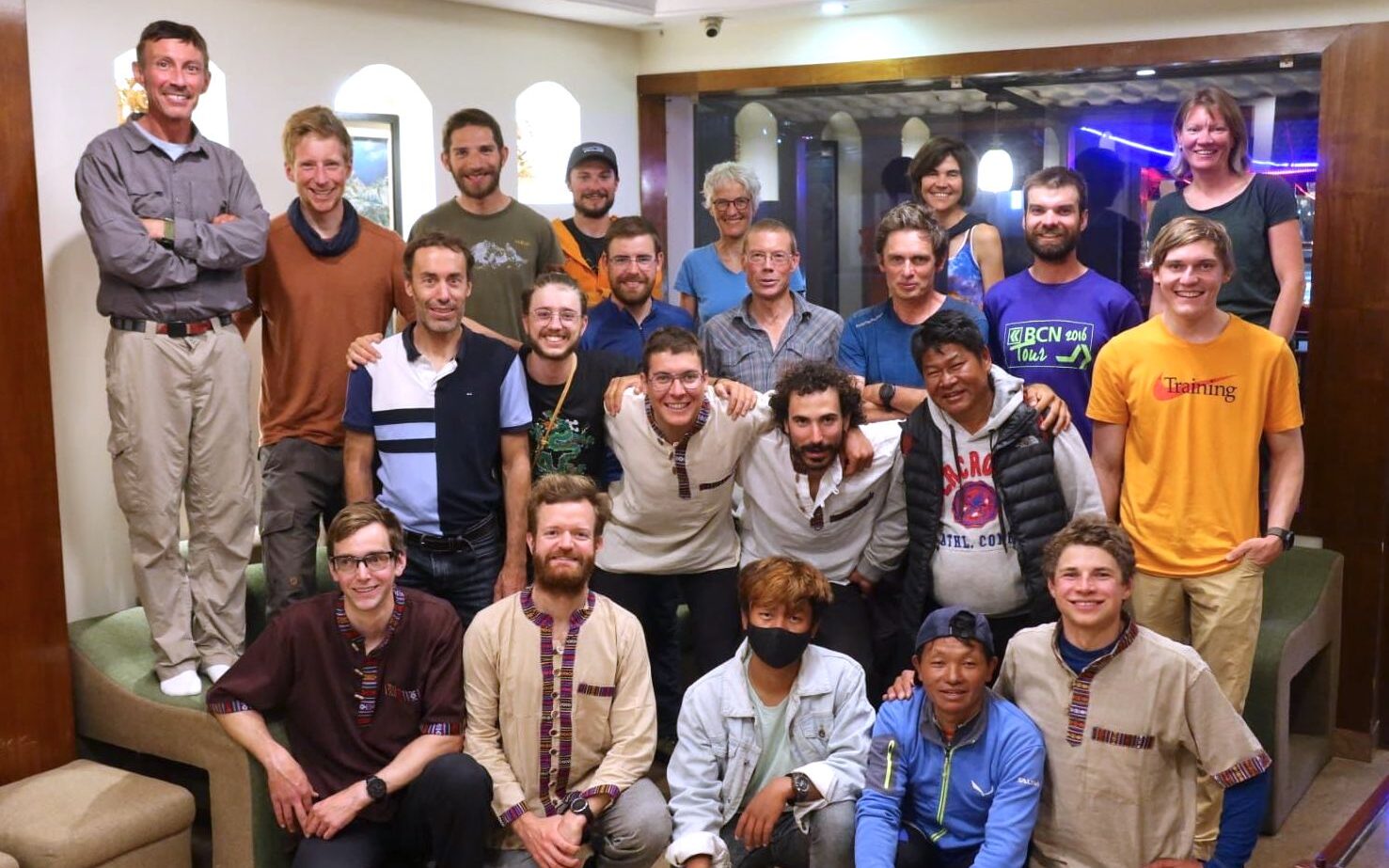
Sustainability:
It isn’t possible to stage an expedition without incurring a significant carbon footprint. To deal with this, we double-offset our travel-related emissions, which were estimated as 3.2 tonnes of CO2 per person. We offset one round of emissions by investing in the efficient cooking stoves produced by RIDS, at a cost of 80 CHF per person. We then offset the same amount a second time by investing in tree-planting in Nepal through Eden Reforestation Projects, at a cost of 20 CHF per person.
Aid Projects
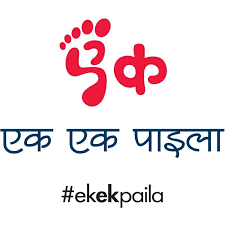
Ek Ek Paila is a Nepalese NGO run by volunteer doctors to provide medical services to all the poor and remote communities in the country. In 2021 we collected 16300 CHF to support their medical projects, with the specific aim of funding 125 cataract operations, restoring sight to affected elderly people. After pandemic delays, the update is that they have used part of these funds for 70 cataract operations carried out at a paila (medical camp) in Rukum (a village in Humla), 1 general paila, anti-Covid work and other activities at their new health centre in Kathmandu and to provide further support for the new hospital they are helping to build and equip in Jajarkot (Humla).
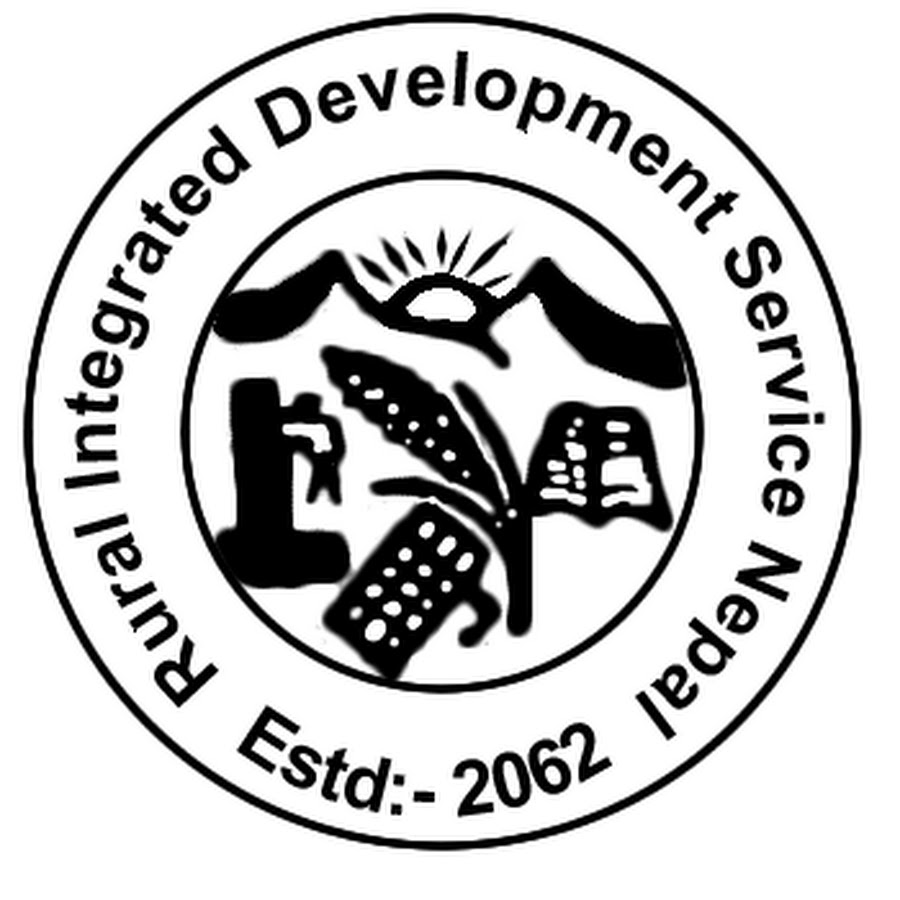
RIDS is a Swiss NGO that has worked for decades at the grassroots level, helping villages with basic infrastructure such as toilets, water supplies and cooking stoves. For the 2022 expedition we are supporting RIDS in installing these facilities in the village of Durpa, near Simikot, and to date we have gathered approximately 13000 CHF (of the 20000 CHF target).
Simikot hospital is a district-level hospital that constitutes the primary (although for many things only) care centre in the Upper Humla. Although its construction and staffing are supported by the Nepal Austria Trust, many of its facilities remain somewhat rudimentary. We donated all the surplus expedition medicine to the hospital.

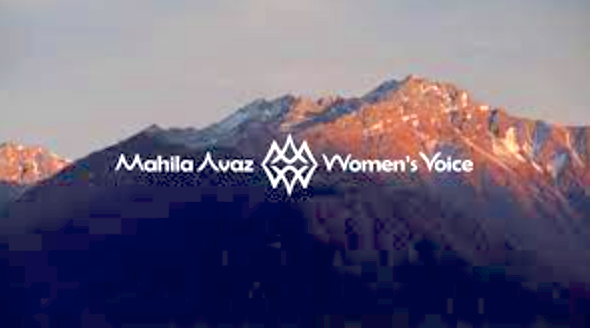
Mahila Avaz – Women’s Voice: the women’s shelter run by Mahila Avaz is the current project of Choepal Dorje, the father of Manu’s god-daughter, and is also supported by the Nepal Austria Trust. We donated all of our remaining base-camp food to the shelter.
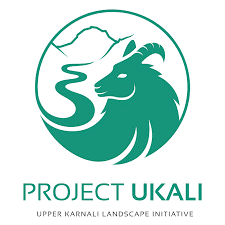
Project UKALI is an initiative run by Humla-born wildlife biologist Rinzin Phunjok Lama. Its aim is not only to monitor snow leopards and the other biodiversity of the upper Humla, but to play an active role in improving their status. We donated all our surplus camping supplies (high-camp food and gas) to aid with their fieldwork campaigns, added surplus camping gear and bought some electronic equipment (solar panels and a powerbank) specifically for Rinzin.
Thanks
- Our agent: Mountain Sun Valley Treks and Expeditions
- A special Thank You to our cooks: Lhotsu, Naranath, Shekhar, Sujit and Amrit.
- Mammut for a discount on equipment,
- Bestard for very low prices on excellent boots and
- Neurologische Praxis Zollikerberg for comprehensive medical support.






